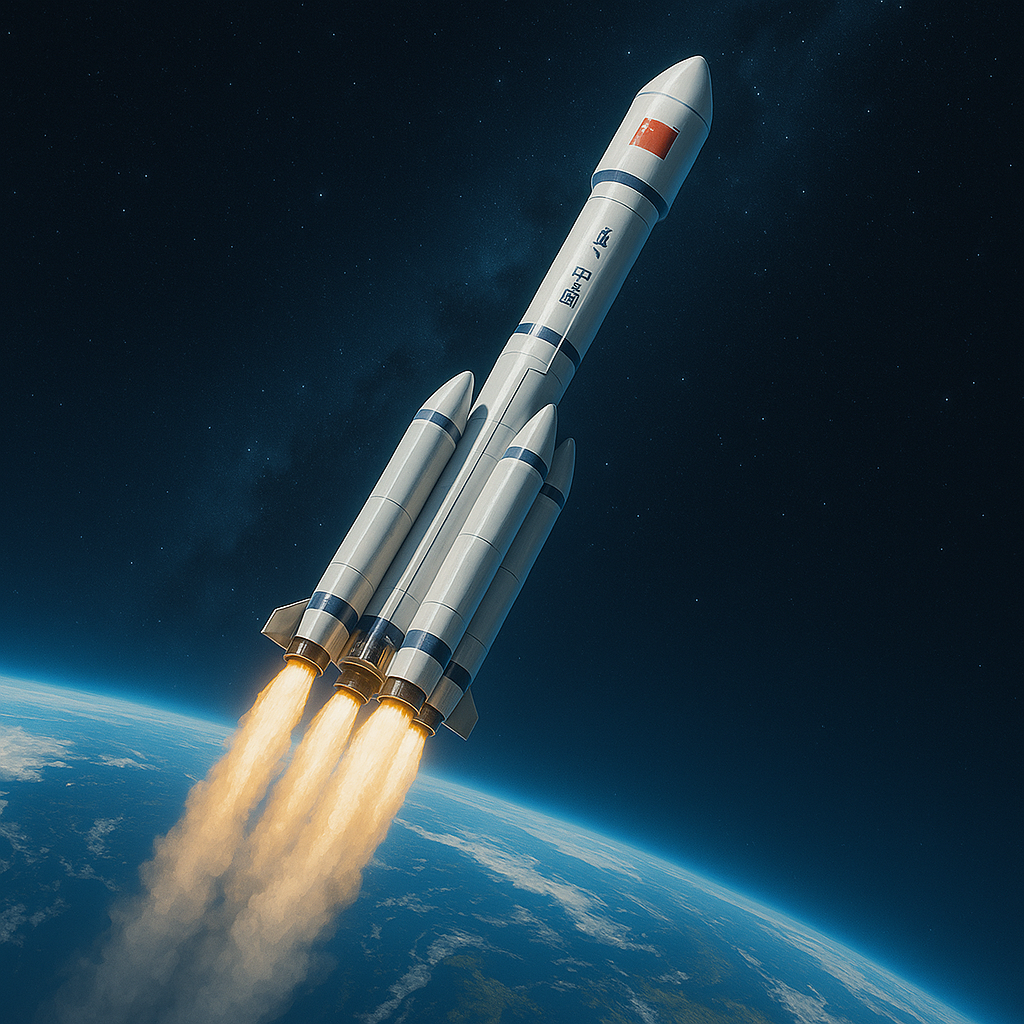By Krzysztof Karwowski (PSJ Editorial Team, SGH Warsaw School of Economics)
On Tuesday, April 15, China confirmed the success of the DRO mission, which established a constellation of satellites designed to test communications in distant retrograde orbit (DRO) around the Moon. This mission marks a significant breakthrough for the future of communication and logistical operations supporting lunar and cislunar exploration activities. The announcement was made by the Technology and Engineering Center for Space Utilization (Beijing), a Chinese Academy of Sciences branch overseeing the mission [1].
A dramatic start
The constellation consists of three spacecraft: DRO-L, launched into a heliocentric orbit around Earth in February 2024, and a pair of lunar satellites: DRO-A and DRO-B, launched together toward the Moon in March of this year. The twin satellites drew media attention when they were placed in jeopardy after their launch from Xichang Cosmodrome in Sichuan. Due to the anomaly of the upper stage of the Long March rocket – specifically the Yuǎn Zhēng (远征) lunar transfer module—the satellites failed to reach their intended trajectory [2].
Despite the complications, the operation ended successfully. A rapid-response recovery mission requiring nearly six months of exhaustive and highly precise orbital manoeuvres finished in August, when both satellites finally reached their planned orbit, securing a critical step forward in China’s cislunar communication ambitions [3].
The DRO Satellite Constellation Mission
Thanks to the high stability of the DRO orbit and its capacity for low-energy orbital manoeuvres, it is regarded as an especially desirable location for deploying lunar communication and navigation satellites. The strategic placement of three satellites: two in lunar orbit and one heliocentrically localized around Earth – also enables precise positioning measurements of each element of the constellation, a capability China has demonstrated.
The deep space navigation for Chinese missions relies currently on three core components. The first is a ground-based telemetry infrastructure located on the Chinese territory, complemented by two stations abroad: one in Swakopmund (Namibia, Africa) and another in Lejano (Espacio Lejano, Neuquén, Argentina). The second element consists of mobile antenna arrays installed on specially built deep-space telemetry and tracking vessels: the Yuǎn Wàng (远望) and Liǎo Wàng (了望) ships, which provide signal support and connection during global maritime voyages. The third component is the Běidǒu (北斗) Chinese satellite navigation system, whose latest generation, Běidǒu-3, reached global coverage in 2020 [4]. Despite the sophistication and redundancy, lunar orbital navigation continues to demand extreme precision, which is most effectively achieved by conducting navigation in situ. The successful demonstration of the DRO satellite mission provides China with valuable experience and a foundation for constructing a larger, more advanced lunar constellation in the future.
ILRS [5]
The DRO mission is one of a series of projects performed in parallel with the Chinese Lunar Exploration Program CLEP/Chang’e (嫦娥), which ultimately aims to establish the International Lunar Research Station (ILRS). These complementary efforts are designed to develop the infrastructure, technologies, and operational experience necessary to support a crewed flight to the Moon but also long-term multinational scientific presence, with ILRS base as its central platform.
The ILRS is a collaborative initiative led by China and the Russian Federation, aiming to establish a permanent lunar outpost by the mid-2030s. Designed as a multi-phase project, the ILRS will involve both robotic and manned missions focused on long-term exploration, resource utilisation, and scientific research. The station is planned to be located near the lunar south pole, taking advantage of potential water ice deposits. The ILRS will include infrastructure for energy generation, communication, habitation, and scientific operations, and is open to international partners, offering a strategic alternative to NASA’s Artemis program. Current participating countries (besides People’s China & Russia) include: Venezuela, South Africa, Pakistan, Belarus, Egypt, Thailand, Nicaragua, Serbia, Kazakhstan and Senegal [6].
Competition
In addition to China’s DRO satellites, several non-Chinese initiatives are underway to establish lunar-orbiting constellations to support future missions with navigation, communication, and services. Among examples are: Lunar Trailblazer, a scientific satellite mission developed in partnership between NASA and Lockheed Martin, aimed at mapping lunar resources and testing technologies, a European Moonlight initiative launched by the European Space Agency (ESA) in cooperation with Telespazio, with key contributions from the UK and Italian Space Agencies and Alpine and Lupine – joint venture between American and Japanese space startup ispace-US, intended to provide positioning and telecom opportunities in cislunar space.
[1] Xinhua (2025). China Focus: China builds three-satellite constellation in Earth-moon space. Retrieved on 2025/04/17 from Xinhua, https://english.news.cn/20250416/44224631fdc44bb083f27272826097a5/c.html
[2] Xinhua (2024). China’s satellite launch suffers abnormality. Retrieved on 2025/04/17 from Xinhua, https://english.news.cn/20240314/bec5de65a5b042a48d88776048560491/c.html
[3] Jones, A. (2024). Chinese spacecraft appear to reach lunar orbit despite launch setback. Retrieved on 2025/04/17 from Spacenews, https://spacenews.com/chinese-spacecraft-appear-to-reach-lunar-orbit-despite-launch-setback/
[4] Karwowski, K. (2024). Ze smokiem do gwiazd. Chiński program kosmiczny. Retrieved on 2025/04/17 from INE, https://ine.org.pl/chinski-program-kosmiczny/
[5] President of Russia’s Staff (2022). Ratification of the Russia-China intergovernmental agreement on cooperation in establishing the International Lunar Research Station. Retrieved on 2025/04/17 from Kremlin.ru http://en.kremlin.ru/acts/news/74254
[6] Ngangi, S. (2024). Senegal among new members of China’s ILRS moon base project. Retrieved on 2024/04/17 from SpaceAfrica, https://spaceinafrica.com/2024/09/05/senegal-joins-chinas-ilrs-moon-project/
[7] ESA (2025). Moonlight Initiative/Project. Retrieved on 2024/04/17 from ESA, https://www.esa.int/Applications/Connectivity_and_Secure_Communications/Moonlight
[8] Ispace. Introducing ispace-U.S.’s Relay Satellites Alpine and Lupine. Retrieved on 2024/04/17 from ispace, https://ispace-inc.com/news-en/?p=6236


